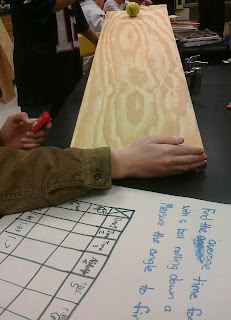Yes. As we are finding out in class, this is one of the most important parts about solving these one-step equations in motion. By writing down the equation and filling in the values and measurement units, one can think if the answer is logical. For instance, if you calculate distance but your answer comes out to be 5 m/s, then you know there is an issue with the set up of the equation. Distance would have units of m for meter or km for kilometer.
Another reason for including units in your calculation is to make sure that the values do not need to be converted. In class we completed several examples where units needed to be changed in order to solve the problem. For simplicity, we know that there are 1,000 m in one kilometer and 3,600 s in one hour. This knowledge will convert most of the units in our motion equations.
Here is a problem from class today:
If a car is traveling 100 km/h and comes to a stop in 3 min, what is the car's acceleration? (round to the nearest hundredth, m/s2)
First, check to make sure you know what the problem is asking you to solve.
Velocity (final) Vf = 0 km/h
Time is = 3 min
Acceleration = ? Solving for acceleration km/h2or m/s2
Converting time to seconds
Converting km/h to m/s
Now that we have the correct units, it’s time to solve the problem using the correct equation.
Velocity (initial) Vi = 27.8 m/s
Velocity (final) Vf = 0 m/s
Time = 180 s
Acceleration = ? Solving for acceleration, m/s2
Velocity (final) Vf = 0 m/s
Time = 180 s
Acceleration = ? Solving for acceleration, m/s2
Using units lets us know that the problem was solved correctly. For acceleration, the problem was to have an outcome with the units m/s2. If we were to solve the problem and a different set of units were to be produced, then we’d know there was an issue in solving the problem.
Update:
Homework:
F3 Homework: Elements of Motion due next science class
F4 Quiz - Motion on Friday!
Extra Credit
VocabTV directions - due Wednesday
YouTube Video blog comment directions - due Thursday









